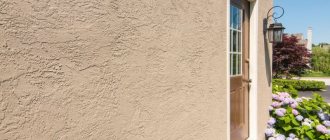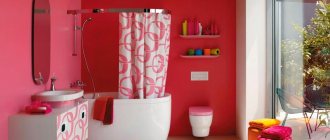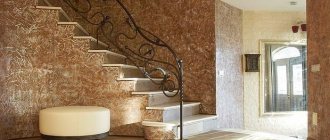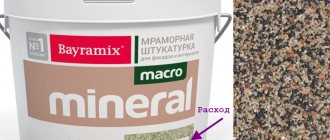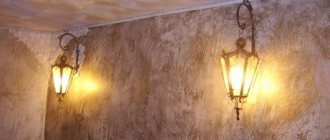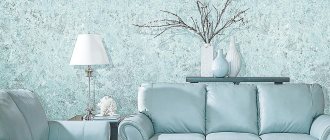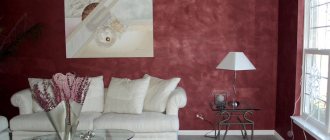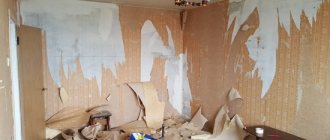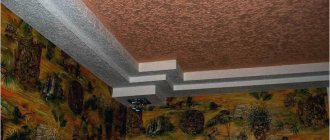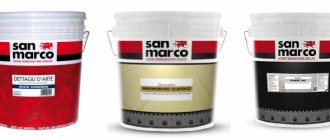Every homeowner wants to see their home beautiful, well-groomed and unique. The good thing is that the use of modern building materials makes it possible to realize most of his fantasies. The entrance hall can be called the face of any home, be it a country residence or a city apartment. Guests form their opinion about the house often under the impression of the hallway and its appearance. And that’s why interior designers pay special attention to it.
Decorative plaster in the interior in the hallway.
For its finishing, many materials are used, and not the least important role among them is played by decorative plaster in the hallway. What it is, how to prepare it and put it into practice, we’ll talk about all this below.
What should the plaster be like?
An example of decorative plaster in the interior.
Plaster composition is essentially a mixture based on a number of components (cement, clay, sand), which is used for the final finishing of walls and ceilings. But, it should be understood that such plaster is fundamentally different from general construction plaster, used for rough processing of walls and ceilings.
Decorative plaster in light colors.
Decorative natural plasters are multilayer coatings that include at least two layers. The first layer is a primer, it must be compatible with the wall material. That is, one primer is used for brick, another for wood, etc. For final finishing, a mixture is used, which consists of a binder component that is saturated with various types of fillers.
Types of plaster
Venetian plaster in the design of the corridor.
When carrying out finishing works, the following types of decorative plaster are used:
- Ordinary monolithic plaster;
- Terrasite;
- Venetian;
- Bark beetle;
- Modeling and many others.
Textured plaster in room design.
Terrasite plaster is intended mainly for exterior finishing. But in the modern building materials market, where plaster of this type is presented, there is also one adapted for indoor use. It consists of Portland cement, limestone flour and quartz; there are other compositions, for example, which include mica crumbs.
Types of terrazite plaster for finishing.
Venetian plaster includes stone flour. Usually marble is used to obtain it. In addition to it, granite, malachite, etc. are used. It is added to the finished plaster mixture and then applied to the prepared wall.
Wall decoration with Venetian plaster.
Corridor plaster of the bark beetle type is available in two versions - acrylic and gypsum. The first plaster is a ready-to-use mixture. The gypsum composition is a mixture that will need to be prepared for use. It includes marble granules or mineral chips. Their size determines the grain size of the material and its appearance.
Structural paint and flocking
Example of structural paint for wall covering.
One of the new building materials is structural paint, sometimes called textured paint. Recently, it has become widely used for finishing work. This paint allows you to create any pattern, and thus can be used instead of wallpaper. But this material has a significant drawback - high cost. On the other hand, its service life can be counted in decades, and this will more than pay for its costs. What distinguishes it from ordinary paint is not its composition, but the method of application to the wall surface.
Flock is a filler that is added to paints to create a more impressive look. To obtain it, wool, cotton, etc. are used; it is also made from polymers.
What is silk plaster
The solution also has a second name - liquid wallpaper. Both names are correct. But there is still a difference that sets silk plaster apart from other types of finishing. It contains silk fibers, which is why this coating is also called velvet. The mixture includes an adhesive base, particles of cotton and cellulose. Sparkles may be added.
Blue silk plaster Source stroy-podskazka.ru
Combination of finishing materials
Combination of decorative plaster and wallpaper in the hallway.
Textured plaster is often laid at the bottom of the wall. It is most susceptible to contamination; the upper part can be covered with wallpaper. The columns are finished in the same way.
Textured plaster is a beautiful material, and if you divide a wall using a baguette or plinth and apply mortar, it will be possible to get the illusion that the walls are covered with marble or other finishing stone, for example, malachite.
The combination of several types of coatings in one space allows you to decorate the wall as a full-fledged panel. By the way, this move is used by designers when decorating and decorating spacious hallways or halls.
Advantages of decorative plasters
DIY bas-reliefs made of plaster on the wall.
This finishing material has gained wide popularity due to the fact that it has a number of undeniable advantages:
- Decorative plasters in the corridor are laid on the wall quite easily. But this requires strict adherence to the instructions for using ready-made formulations.
- In order to lay it on the wall, you only need a trowel, spatula or roller.
- The main difficulty when laying the composition is careful preparation of the wall. But more on that below.
- The use of this type of plaster masks almost any wall defects. Once it's in place, even the most wavy walls will look like it was intended by the designer. But the walls still need to be prepared early.
- In addition to decorating the walls, this composition acts as thermal insulation. To do this, it is necessary to treat the walls, and the solution must be of a certain type. By the way, some manufacturers produce and sell special compounds with enhanced thermal insulation properties, which can take on the function of insulating a room (corridor).
- Today, the use of decorative plaster allows you to create non-traditional types of interior design for the corridor. Moreover, the use of this material guarantees that the created interior will be unique.
- A wide selection of plaster of this class allows it to be used in various styles from empire to high-tech.
- For the most part, this material is environmentally friendly. It contains natural materials that are safe for humans. It does not absorb odors and does not emit any substances that could harm residents or pets.
Examples of design in various styles
This decorative design can be chosen for a hallway designed in almost any style direction.
The photo shows a loft-style corridor with walls decorated with concrete-like plaster.
Preparing the wall for decorative plaster
Various drawings and landscapes on the wall are made using decorative plaster.
Laying plaster is the final stage of construction work in the hallway, and its implementation requires certain skills. That is, the installation of door and window structures must be completed, the work associated with rough processing of the walls and ceiling must be completed. The corridor is cleared of construction debris and associated dirt.
Combination of decorative plaster and stone in the interior.
Preparation for plastering is similar to preparation for painting. The wall must be leveled, scratches, chips, and potholes must be eliminated and covered with acrylic-based primer. If the surface being prepared is not dense enough, then it must be treated with either a strengthening compound or a restorative primer. The soil not only strengthens the wall, but also provides protection from excess water and increases the adhesion of the coating to the base. When preparing the wall, it is treated with antiseptic solutions that resist fungus and harmful microorganisms.
Detected cracks are “opened” and sealed with a special solution.
The primed surface is puttied. This operation is repeated several times and each layer must dry for about 24 hours. To protect the surface from cracks, serpyanka or non-woven wallpaper is used. The places where their strips meet must be carefully puttied.
Decorating the hallway walls with decorative plaster.
A deep penetration primer composition made on an acrylic base is applied to each layer of putty. When preparing the base for laying the composition, it is unacceptable to use materials based on alabaster. For grinding, use abrasive paper with fine grain.
Before you start painting, you need to do a test. This is necessary in order to evaluate the quality of the coating texture.
How to make a craquelure effect with your own hands using two-component varnish
Here's how to create a craquelure effect with two-component varnishes. Craqueling with a two-component varnish has a more complex technology, but the result is impressive.
The surface is painted with background paint and dried. Then a two-component crackle varnish is applied in as thin and uniform a layer as possible. The brush, preferably a foam one, should move only in one direction, since the stripes of varnish should be as even as possible.
After the first coat of varnish has dried and becomes transparent, apply the second coat. It can be made thick, and the thicker this layer is, the brighter and deeper the cracks will be. When applying varnish, the brush should move crosswise in relation to the first layer.
Then the surface is covered with a finishing layer of paint and dried. It is better to use a fan to dry it or be patient and wait a few days. If you use a hairdryer to dry, the depth and width of the cracks will be even greater. The entire decorated wall must be treated with acrylic varnish and dried.
To enhance the brightness of the cracks, dark dye, gold or silver powder is collected on a sponge and gently rubbed into the recesses. Excess paint can be wiped off using a cloth and vegetable oil.
Craquelure must be properly cared for, otherwise the decorative layer will be damaged. Do not knock on the surface. The finish may crumble if it is strongly touched by something hard (for example, when installing furniture). The coating must not be cleaned, rubbed or wetted excessively. Cleaning is allowed with a soft cloth dampened in clean water. You should not get carried away with wet cleaning; it is enough to do it once a week. It is almost impossible to restore a damaged layer of craquelure unnoticed, and only an experienced craftsman can do this.
In the video “Do-It-Yourself Craquelure” you can learn more fully about all the intricacies of the process of aging surfaces:
Plaster application technology
Drawing a pattern on decorative plaster.
Laying plaster is not a very complicated process. At least no more difficult than working with traditional materials. But the cost per square meter of its creation can reach several thousand rubles.
But as practice shows, a lot depends on the parameters of the mixture. You can buy mixtures with different characteristics on the market, and it is quite enough to strictly follow the instructions, which are always on the packaging.
How to apply plaster on walls correctly
Applying plaster in a thin layer.
Thin single layer coatings
They imitate fabric trim. These compositions are applied to previously prepared surfaces and have a minimum permissible thickness. This coating looks like fabric. This composition is applied with a brush. The solution contains polymer binders and crushed filler (glass, metal-based pigment, etc.).
"Fur coat"
Decorative plaster for walls view-fur coat.
After applying this composition, a rough, gray surface is formed on the wall. Its color can be adjusted with tinting additives. To obtain the texture, the finished solution is spread with a trowel and leveled with a wide spatula or steel trowel. This is considered to be the simplest form of plaster texture. To achieve the final appearance, a textured material, such as a brush or a piece of faux fur, is applied to the area of the wall where the coating was recently applied.
When the applied layer is ready, it is covered with a varnish coating.
Some subtleties
A beautiful combination of wallpaper and plaster for the walls.
When performing plastering, it is advisable to take into account the following subtleties of work:
- Mixtures containing large solid particles are applied by hand;
- Water cannot be added to prepared formulations;
- When choosing a water-based composition, you must remember that they are more susceptible to damage, excessive humidity and temperature fluctuations;
- If the period of use has passed or the storage rules were not followed, then the plaster in the corridor may not fit on the wall.
Pros - cons
Having obtained a general idea of the most important characteristics of compositions of this type, it is necessary to clearly understand that they have both their pros and cons. The positive qualities include the following:
- Compositions of this type do not burn and are fireproof.
- The service life of a Venetian is measured in tens of years.
- The appearance of the walls after decoration will be beyond competition.
- Individuality will also be exceptional - it is impossible to find two identical walls or ceilings.
The disadvantages include the very difficult process of creating a decorative layer and the very impressive cost of the mixtures necessary for the work.
Patterns for decoration
In addition to the basic parameters of this class of plaster, there is a set of techniques that can be used to decorate the walls in the hallway.
Stencil designs
Decor on plaster using a stencil.
In modern terms, painting is a trend in modern design. To obtain it, a template (stencil) is used. Painting can be applied to any surface. It allows you to make a repeating pattern on the entire wall. The painting can be further processed, for example, subjected to artificial aging.
Volumetric drawings
Drawing three-dimensional designs on plaster.
Before creating it on the wall, it is advisable to make a preliminary sketch on paper. These drawings are different in that they have a 3D effect. Such a design can be included in a large wall painting or can be made as an independent composition. It is better to invite a professional decorator to perform it.
In fact, methods of decorating wall coverings are not limited to the examples given. There are many more of them, for example, imitation stone.
Coating textures
Silk plaster can be of different textures and densities, it depends on the density of the coating, the method of its application, as well as the characteristics of the composition and consistency. The coating can be quite smooth or velvety. In the first case, the plaster contains thin threads, dyes and metal pigments. The pattern acquires a voluminous effect due to inclusions of mother-of-pearl, which sparkle and shimmer on the walls. Unlike liquid wallpaper, silk plaster is created from astringent acrylic polymers, as well as polyester fibers and quartz chips. The most important ingredients are cotton threads and cellulose. Plasticizers extend the life of the mixture.
Plaster with wet silk effect Source stroidominvest.ru
